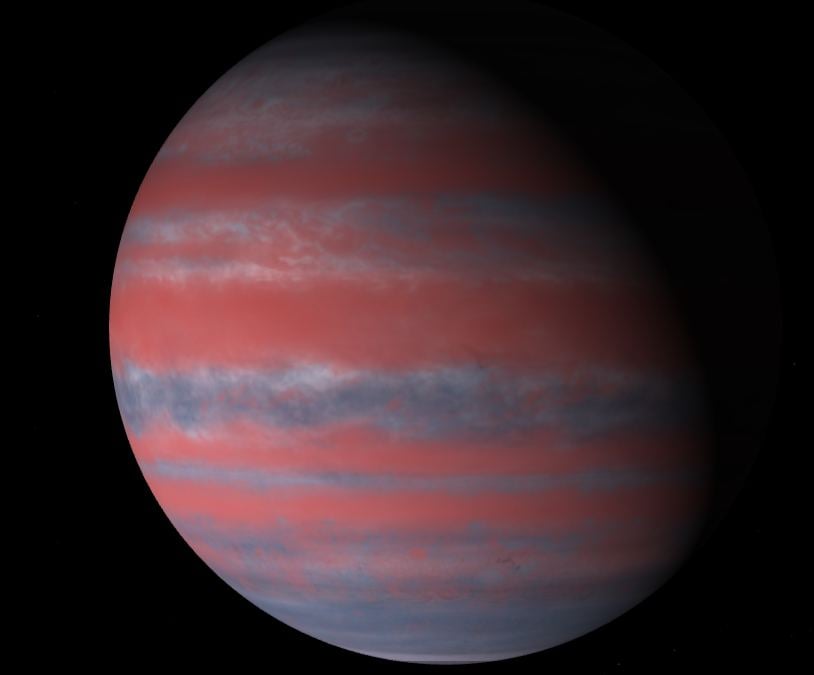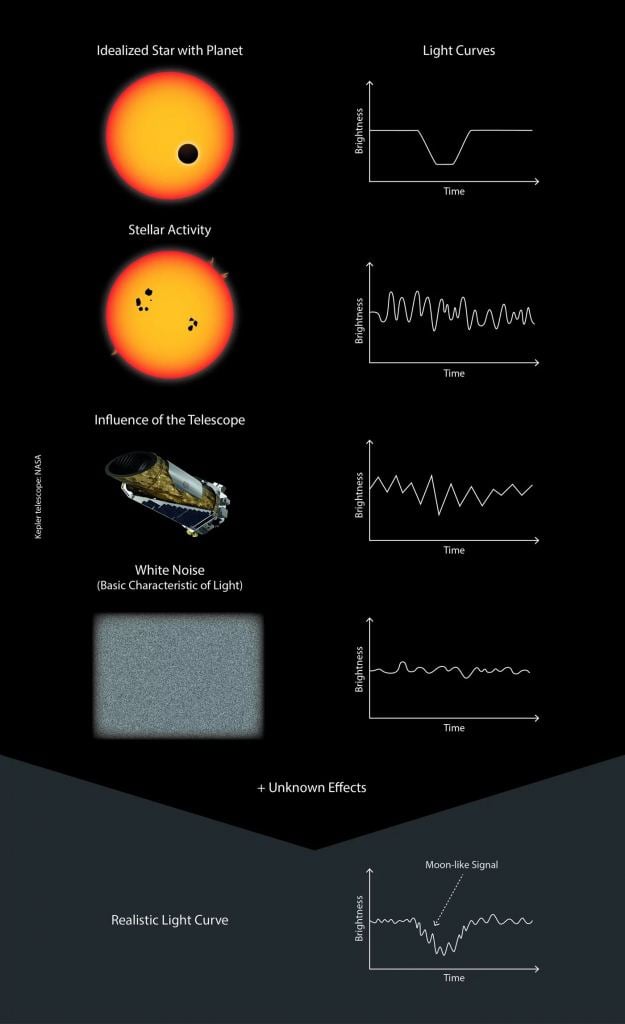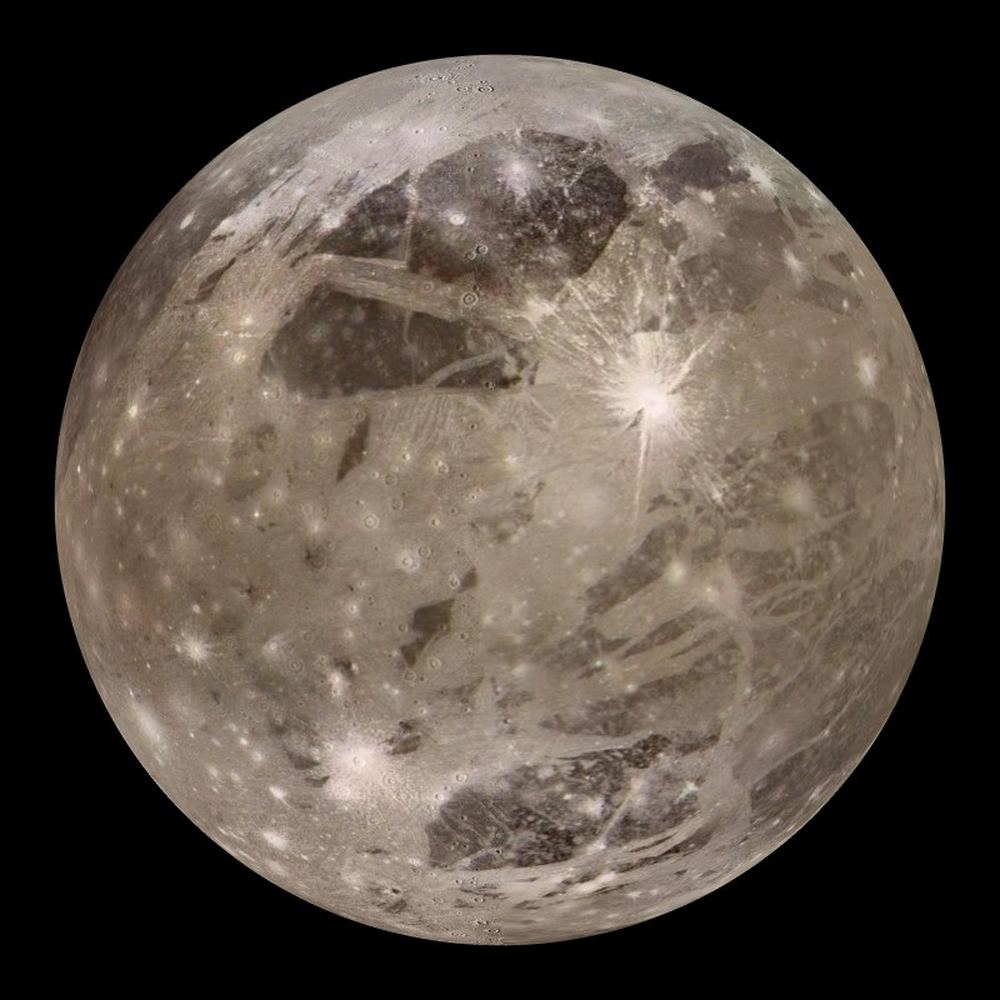For a long time, we wondered if other stars hosted planets like the Sun does. Finally, in the 1990s, we got our answer. Now, another question lingers.
Most of the planets in our Solar System have moons. Do exoplanets have exomoons?
Moons are the norm in our Solar System. Only Mercury and Venus, the two planets closest to the Sun, don't have moons. Mercury is too small to maintain a hold on a moon so close to the Sun, and Venus may have had one in the past and then lost it. On the other end of the scale are our two gas giants, Jupiter and Saturn. Together, they host almost 250 moons, though many of them are very small.
There's no reason to think that planets in other solar systems don't have moons. But just like with exoplanets, we don't know until we know.
We thought we knew six years ago when researchers at Columbia University found evidence of a giant moon orbiting the exoplanet Kepler-1625b. They were suitably cautious with their findings, making certain people understand that they had found only a candidate moon in the Kepler 1625 system. "This candidate has passed a thorough preliminary inspection, but we emphasize again our position that the Kepler data are insufficient to make a conclusive statement about the existence of this moon," the authors wrote. They hoped that follow-up observations with the Hubble Space Telescope would confirm it. "Only after the HST observation is made should any claim about this moon's existence be given much credence."
Hubble never did confirm it, but Kepler 1625b wasn't the only exoplanet with a potential exomoon. Kepler-1708b also exhibited signs of an orbiting exomoon. Now, new research suggests that what scientists were seeing in the data are not exomoons.
Exomoons are extraordinarily difficult to detect. When exoplanets are hundreds or thousands of light years away, we can only detect them when they block their star's light. That's already a monumentally difficult task that's plagued with false positives and other obstacles. Exomoons are much smaller and far more elusive, making their detection dramatically more difficult.
"Exomoons are so far away that we cannot see them directly, even with the most powerful modern telescopes," explains Dr. René Heller. Heller is from the Max Planck Institute for Solar System Research (MPS) and the first author of a new research article in Nature Astronomy. It's titled " Large exomoons unlikely around Kepler-1625 b and Kepler-1708 b, " a title that needs no parsing.
Kepler 1625b is a Jupiter-size planet orbiting a Sun-like star over 8,000 light-years away. When its potential moon was discovered, it generated lots of interest. Not only because it would've been the first one, but it also would've been a gigantic behemoth moon as large as Neptune that dwarfed all of the moons in our solar system.
Kepler-1708b orbits an F-type star over 5,000 light-years away. In 2021 astronomers found evidence of an exomoon orbiting the Jupiter-like gas giant. If real, it's also an enormous moon. "The moon is pretty alien compared to any moon in the solar system," said David Kipping, an astronomer at Columbia University involved with the discovery. "We're not sure if it's rocky; we're not sure if it's gaseous. It's kind of in between the size of Neptune, which is gaseous, and the Earth, which is rocky," Kipping said in an interview with NPR.
We tend to think of exoplanet discoveries as more direct than they really are. In the past, astronomers would sit at their telescopes carefully observing the sky until they found something. But modern astronomy isn't like that. Spacecraft like Kepler and TESS generate an enormous amount of data, and it's up to scientists to make sense of it and find the discoveries in all that data. These exomoons were discovered in a deep analysis of Kepler data.
Astronomers look for light curves in Kepler data. When they find one that dips regularly, it indicates an exoplanet. Exomoons would also produce light curves, but they're more complicated than exoplanet light curves due to the moon's and the planet's movement around their shared center of gravity. They're also so faint that they're little more than a wisp. But faint indications are where a lot of important scientific findings began.
One of the problems with faint indications is that they look the same as noise signals. And all telescopes introduce their own noise. How can scientists tell the difference? Only with hard work and powerful computational tools.
In this case, the pair of researchers behind the new article generated millions of artificial light curves that exomoons would generate in a wide variety of scenarios. Then they used an algorithm to compare all of these curves with the detected curves from both Kepler-1625b's and Kepler-1708b's potential exomoons.
In Kepler-1708b's case, the results were not good. Moonless scenarios did a better job of reproducing the light curves better than exomoon scenarios did. "The probability of a moon orbiting Kepler-1708b is clearly lower than previously reported," said research co-author Michael Hippke from the Sonneberg Observatory. "The data do not suggest the existence of an exomoon around Kepler-1708b," Hippke added.
Kepler-1625b's exomoon also didn't survive the analysis. The signals indicating its presence came from how the two telescopes used to study it—Kepler and Hubble—see things differently. It all comes down to limb darkening.
Limb darkening is the instantaneous change in brightness of a star across its disk as an exoplanet passes in front of it. Heller and Hippke argue that limb darkening has a powerful impact on the proposed exomoon signal. The limb of the solar disk appears darker than the star's center. But the limb darkness appears different between Kepler and Hubble because both telescopes are sensitive to different wavelengths of light. In a real exomoon transit, it wouldn't make any difference.
The pair of researchers say that their modelling explains the limb darkening difference better than an exomoon can. They also say that their new analysis shows how exomoon-detecting algorithms generate so many false positives. Astronomers keep thinking they've detected an exomoon then it turns out to be just a planet.
"The earlier exomoon claim by our colleagues from New York was the result of a search for moons around dozens of exoplanets," says Heller. "According to our estimates, a false-positive finding is not at all surprising but almost to be expected," he adds.
This research has another positive outcome. It shows what types of exomoons are more likely to be detectable. The pair's analysis shows that only massive moons on wide orbits are likely detectable. A detectable moon would have to be twice as large as Ganymede, our Solar System's largest moon.
How long will we have to wait before we discover our first confirmed exomoon? The ESO's PLATO (PLAnetary Transits and Oscillations of stars) is scheduled to launch in 2026. Its mission is to search for transits of Earth-like planets across up to one million stars. It'll excel at detecting planets but also has the power to detect rings and moons.
"The first exomoons that will be discovered in future observations, such as from the PLATO mission, will certainly be very unusual and therefore exciting to explore," says Heller.
The pair of authors aren't happy they've shown that the pair of exomoons are unlikely to be real. "We would have liked to confirm the discovery of exomoons around Kepler-1625b and Kepler-1708b," said Heller. "But unfortunately, our analyses show otherwise," he adds.
 Universe Today
Universe Today



